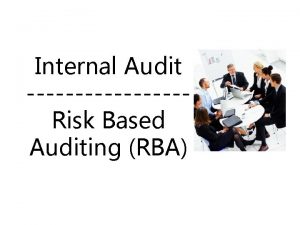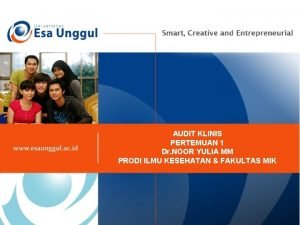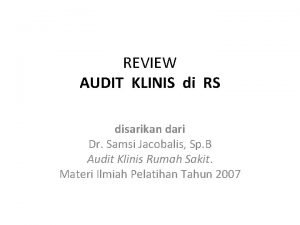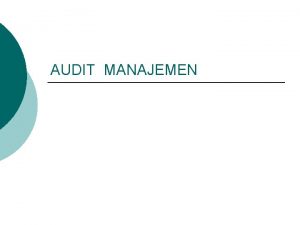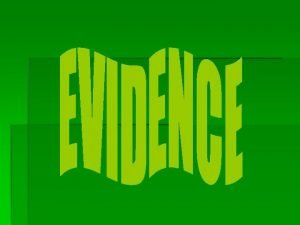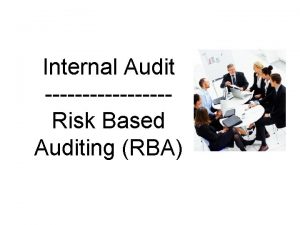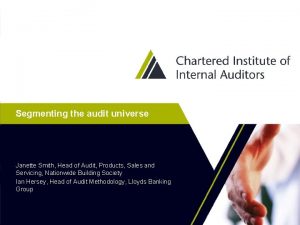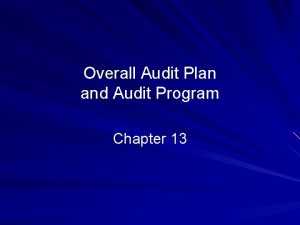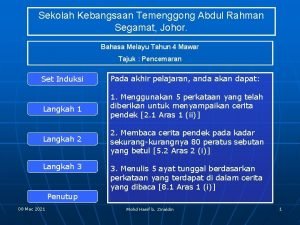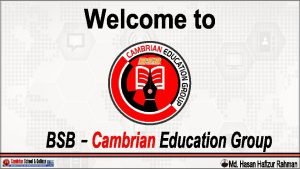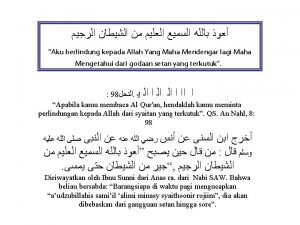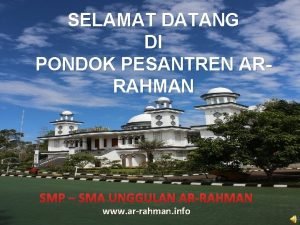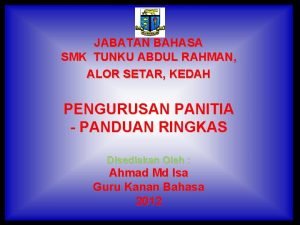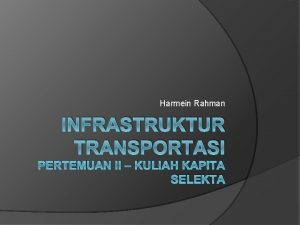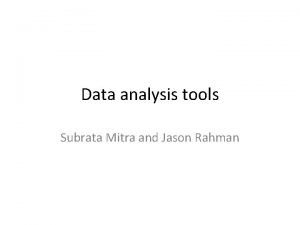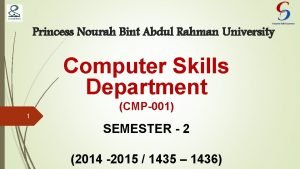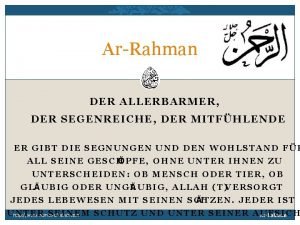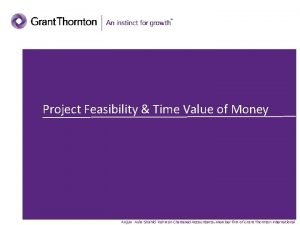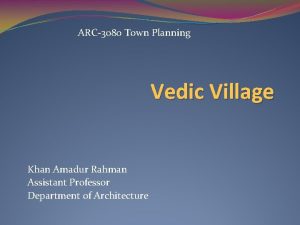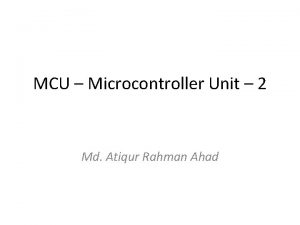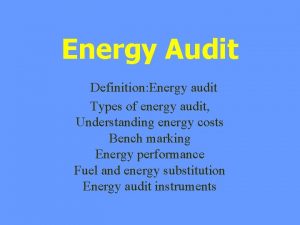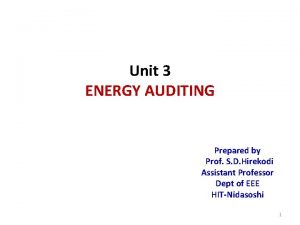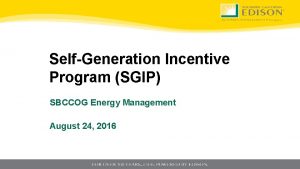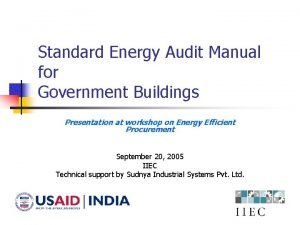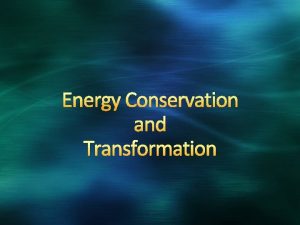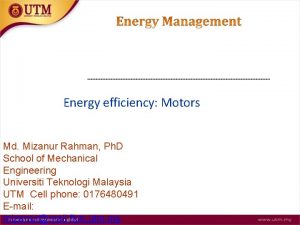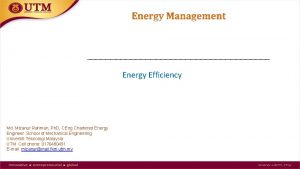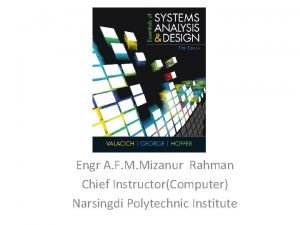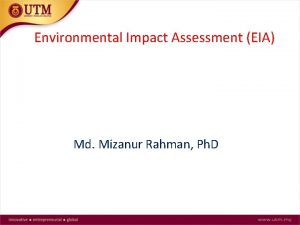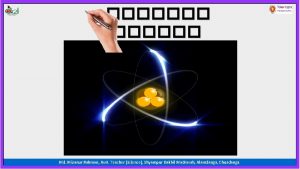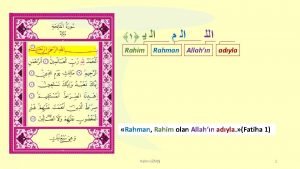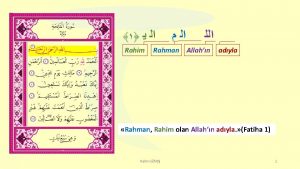Energy Audit EA Md Mizanur Rahman Ph D































































- Slides: 63

Energy Audit (EA) Md. Mizanur Rahman, Ph. D Certified Energy Manager

What is an energy audit? • An energy audit is a periodic examination of an energy system (or part of the system) to ensure the most appropriate sources of energy are employed, and this energy is used as efficiently as possible. • Energy Audit - the periodic survey, measurement, reporting, analysis and examination of an energy system (or part of the energy system) • An energy audit involves an analysis of a facility to determine the forms of energy used, the quantities and costs of the various forms of energy used, the purposes for which the energy is being used, and the identification of energy conservation opportunities

• An energy audit serves the purpose of identifying where a building or plant facility uses energy and identifies energy conservation opportunities • a detailed analysis. . . of the productivities of energy in the various subsystems, and the deficiencies observed. . . [which] should, if properly designed, lead to proposals for correcting the deficiencies, cost effectively • a systematic assessment of where, why and how energy is used in buildings and how well this energy is controlled

An energy audit comprises a detailed analysis of the energy performance of an organization, equipment, system(s) or process(es). It is based on appropriate measurement and observation of energy use, energy efficiency and consumption. Energy audits are planned and conducted as part of the identification and prioritization of opportunities to improve energy performance, reduce energy waste and obtain related environmental benefits. Audit outputs include information on current use and performance and they provide ranked recommendations for improvement in terms of energy performance and financial benefits 2

5

EA is a top-down initiative – its effectiveness relies on the resources that should be allocated to energy audit by the management Commitment on energy conservation and environmental protection Anticipation on the energy savings achievable Aspiration of the improvement to corporate image by promoting energy efficiency and conservation 3

Objectives of EA The less energy is consumed the less fossil fuels will be burnt Thus building owners and power producers will generate relatively less pollutants and by-products Therefore all parties contribute to conserve the environment and to enhance sustainable development 4

Why conduct EA? To develop database To determine if energy is being used efficiently Identify opportunities for saving energy Identify cost savings Highlight potential improvements to existing systems Assist in planning for future expansion

Who would benefit? Everybody - through conserving energy and protecting the environment Commercial building owners • longevity of plant and equipment Building and facility managers • reduced operating costs Site engineering and maintenance staff • increased plant efficiencies

What are the benefits of EA? Energy savings Avoiding power factor penalties Quality improvements Productivity improvements Reduced maintenance Fewer breakdown Better safety and protection 7

EA types • Energy audits are the first step to improve the energy efficiency of buildings and industrial facilities. • Energy audit is one of the tools of energy management • Generally, four types of energy audits can be distinguished as briefly described below: i. Walk-through energy audit ii. Audit of historical data iii. Standard energy audit iv. detailed energy audit 11

1. Walk-through audit Consists typically of a short on-site visit of the facility to identify areas where simple and inexpensive actions (typically operating and maintenance measures) can provide immediate energy-use and/or operating cost savings. 2. Historical data audit A careful evaluation of metered energy-uses and operating costs of the facility. Typically, the utility data over several years are evaluated to identify the patterns of energy-use, peak demand, weather effects, and potential for energy savings. 12

3. Standard energy audit Consists of a comprehensive energy analysis for the energy systems of the facility. It includes the development of a baseline for the energy-use of the facility, the evaluation of the energy savings, and the cost-effectiveness of appropriately selected energy conservation measures 4. Detailed energy audit It is most comprehensive but also time-consuming energy audit type. It measures energy-use for the whole facility. Sophisticated computer simulation programs are typically considered 13

Energy audit can also be classified as: Preliminary audit Detailed audit Investment audit

Preliminary Audit Allows the overall energy consumption of the facility to be evaluated. Gives an overview, providing a rough estimate of savings and costs. Designed to determine if the level of energy use in the building has been reasonable or excessive. It provides initial benchmarks of the building.

Preliminary Audit Scope of work for preliminary audit is as follows: Gather building wide energy use on monthly and/or annual basis Derive performance indicator (k. Wh/m 2/year for building, k. W/ton for air- conditioning unit, W/m 2 for lighting load) Broad conclusions and recommendations Written report.

Data Collection One of the key tasks in energy auditing is the collection of all energy related data, which allows the Energy Manager or Energy Auditor to apportion the total facility energy consumption to various energy end-uses and build a reliable picture of where, how much and at what cost energy is being used at various end-uses. Data collection is one of the most laborious tasks in energy auditing and the inability to collect the required data will lead to unreliable energy audit results.

Desktop Data Collection It is advisable to start the desktop data collection by gathering the overall energy related data for the audited facility. Questionnaires are prepared for data collection for manufacturing and building facilities. Before the start of an energy audit, the facility engineer should complete the questionnaire(s). This is to save the Auditor time. Desktop data collection includes gathering all data related to audited facilities, processes and/or energy end-uses. This includes all facility drawings, electricity supply, metering, energy consumption and production details (if it is relevant).

Using desktop and field data, the Auditor should be able to estimate the annual energy consumption of various energy end-uses. The total annual energy of end-uses should match the actual annual energy consumption of the whole facility. It is normal to find discrepancies between the estimated and actual annual energy consumption. The high level of discrepancy indicates to the Auditor that there are errors in calculations or used assumptions in calculating the annual energy consumption. In this case the Auditor should review all calculations until he or she is satisfied with the result.

Detailed Audit Identifies the source of energy to a building, the amount supplied and what the energy is used for. Identifies areas where savings may be achieved, recommends measures to be taken and provides a statement of costs and potential savings. Involves short term metering and logging.

Detailed Audit Scope of work Follow-up from preliminary audit and report where available Detailed building and system’s energy input and energy use Reconciliation of energy accounts with loads Variation of energy on month-to-month basis Energy performance indicators Recommend improvement work with indicative cost and saving Written report and presentation.

Field Data Collection The field data collection is a critical step in Energy Auditing. Through this process the Energy Auditor is able to: Complete the missing data not available to the Auditor during the desktop data collection process. Verify certain data collected during desktop data collection process. Understand closely certain manufacturing processes, make observations about energy wastes and maintenance status in the facilities. Carry out necessary field measurements required to build energy and mass balance of the audited facilities.

Data Logging • Using energy data logging equipment, the Energy Auditor can monitor the distribution of energy between various parts of the audited facilities. To capture the pattern of energy uses in the audited facility, the daily load curves should be obtained for a number of days, i. e. 2 days to a week or more. • Using the recorded daily load curves, the Auditor should be able to estimate the total annual energy end- uses of the whole audited facility. The estimated annual energy consumption of the whole facility should be equal to the actual facility annual energy consumption.

Investment Audit Provides a detailed analysis of energy usage, the savings that can be made, and the cost of achieving those savings May cover the whole building or may concentrate on an individual item and/or system Involves long term detailed metering and data logging.

Investment Audit Scope of work Detailed metering down to half-hourly interval where required Derive target energy use and develop baseline model where relevant Detailed recommendations including costs, savings and accuracy of estimates Detailed investment plan Written report and presentation

Electrical energy audit Areas covered under electrical audit: Electrical system Electrical distribution system (substation and feeders only) PF improvement Transformer optimization Cable sizing and loss reduction Motor loading survey Lighting system • • 2 1

Mechanical systems Areas covered under mechanical audit: Fans and blowers Exhaust and ventilation system Pumps and pumping system Compressed air system Air conditioning and refrigeration system Cooling tower system 2 2

Thermal system Areas covered under thermal energy audit: Steam generation boilers Steam audit Steam trap survey Condensate recovery system Insulation survey Heat exchanger Waste heat recovery 2 3

Stages of EA 2 4

General Procedure for Energy Audit • Several tasks are typically carried out depending on the type of the audit and the size and function of the audited building • Some of the tasks may have to be repeated, reduced in scope, or even eliminated based on the findings of other tasks • The execution of an energy audit is often not a linear process and is rather iterative • A general procedure can be outlined for most facilities 30

Step 1: Facility and Utility Data Analysis. The main purpose of this step is to evaluate the characteristics of the energy systems Some of the tasks in this step • Collect at least three years of utility data (to identify a historical energy-use pattern). • Identify the fuel types used such as electricity, natural gas, oil, etc. (to determine the fuel type that accounts for the largest energy-use). • Determine the patterns of fuel use by fuel type (to identify the peak demand for energy-use by fuel type). • Understand utility rate structure (energy and demand rates) (to evaluate if the building is penalized for peak demand if cheaper fuel can be purchased). • Analyze the effect of weather on fuel consumption (to pinpoint any variations of energy-use related to extreme weather conditions). 31

General Procedure for a Detailed Energy Audit Step 2: Walk-Through Survey. From this step, potential energy savings measures should be identified. Some of the tasks involved in this step are: • Identify the customer concerns and needs. • Check the current operating and maintenance procedures. • Determine the existing operating conditions of major energy-use equipment (lighting, HVAC systems, motors, etc. ). • Estimate the occupancy, equipment, and lighting (energy-use density and hours of operation). 32

General Procedure for a Detailed Energy Audit Step 3: Baseline for Building Energy-Use The main purpose of this step is to develop a base-case model This model is to be used as a reference The major tasks to be performed during this step are as follows: • Obtain and review architectural, mechanical, electrical, and control drawings. • Inspect, test, and evaluate building equipment for efficiency, performance, and reliability. • Obtain all occupancy and operating schedules for equipment (including lighting and HVAC systems). • Develop a baseline model for building energy-use. • Calibrate the baseline model using the utility data and/or metered data. 33

General Procedure for a Detailed Energy Audit Step 4: Evaluation of Energy Savings Measures. To achieve this goal, the following tasks are recommended: • Prepare a comprehensive list of energy conservation measures (using the information collected in the walk-through survey). • Determine the energy savings due to the various energy conservation measures pertinent to the building using the baseline energy-use simulation model developed in phase 3. • Estimate the initial costs required to implement the energy conservation measures. • Evaluate the cost-effectiveness of each energy conservation measure using an economical analysis method (simple payback or life cycle cost analysis). 34

Energy Audit Report The energy audit report should present in sufficient details: Executive Summary Description of the audited premise/manufacturing process. The historical energy use related to the audited premise occupancy or productions of the manufacturing facilities. The current energy use apportioned by end uses.

The energy saving measures including their implementation costs and estimated savings. The list of names of suppliers and contractors that the client can approach when he/she decides to implement the energy audit recommendation should be included. Strategy for implementing the recommended energy saving measures. Achieved savings after implementation.

Resources for Energy Audit Instruments Auditors Company staff or external consultants Permanent and portable Energy records Budget and time Computers and software tools

38

Information Required For Audits Monthly electricity bills, purchase of energy M&E and structural drawings of building Details of equipment – purchase date, rating, manuals Records of daily characteristics for electricity consumption Log-books with daily, weekly or monthly records Co-operation with in-house staff is indispensable for auditing and even more important during implementation

Required Measurements temperatures and pressures combustion gas analysis flow rates relative humidity water conductivity lighting intensity electricity system measurements

Typical Instruments contact temperature measurement – digital electronic temperature indicators, and range of detachable probes (insertion probes, contact probes for surface temperatures) non-contact temperature measurement – infrared and disappearing filament pyrometers for surface temperatures pressure – electronic pressure gauges and manometers gas analyser – electronic analyser for measuring oxygen, carbon monoxide and stack gas temperature, with automatic calculation of combustion efficiency. pitot tube – for measuring air flow rates to boilers and furnaces.

temperature & humidity – hand held electronic instrument. conductivity – electronic instrument with combined conductivity/temperature probe for monitoring the quality of boiler feedwater and blowdown. photocell light meter electricity – clip – on meters for measuring voltage, current, resistance, power factor, load (k. W), consumption (k. Wh); often combined within one multimeter with computerized memory and printer for making permanent records. data recording – from strip chart recorders to microcomputer data loggers with multiple channels.

Output of Energy Audits Report containing Energy Saving measures (‘IDEAS’) proposals and recommendations !!!!! Provide evidence of profitability with simple calculations !!!! Summarise results for decision makers !!!!

Potential Saving Measures

Reporting (Analysis of Current Performance) a breakdown of the energy consumption by use and source; energy uses accounting for substantial energy consumption; where available and comparable, comparison with reference values of similar processes; a historical pattern of energy performance; expected improvements for energy performance; where appropriate, relationships between energy performance and relevant variables; an evaluation of the existing energy performance indicators and, if necessary, proposals for new energy performance indicators.

Reporting (Identification of improvement opportunities) based on auditors competency and expertise; evaluation of the design and configuration options to address the system needs; the operating lifetime, condition, operation and level of maintenance of the audited objects; the technology of existing energy uses in comparison to the most efficient on the market; best practices, including operational controls and behaviours; future energy use and changes in operation.

Reporting (Evaluation of improvement opportunities) energy savings over an agreed time period or expected operating lifetime; financial savings anticipated from each improvement opportunity; necessary investments; agreed economic and other criteria identified in the energy audit planning; other non-energy gains (such as productivity or maintenance); the ranking of energy performance opportunities; potential interactions between various opportunities.

Classification of Energy Efficiency Measures

Short Term : (Measurement, Control and Maintenance) Thermal System (Maintenance and Control) Boilers and steam distribution network combustion control (air-fuel ratio) blowdown control periodic cleaning of exchanger surfaces maintenance of insulation on the hot utility network make-up water quality control check steam leaks

Electrical System (Maintenance And Control) Electrical Supply And Distribution Network Matching of transformer with the load Proper ventilation of transformer room Operation of standby generators during the peak hours Use of suitable electric tariff Use of daylighting and switching off unnecessary lighting Load control and sharing/duty cycling to reduce the maximum demand

Chiller/Air-conditioning system Accurate temperature and humidity control to suit the need Maintenance of condenser/evaporator coils Adjustment of chilled water temperature Improve performance of cooling towers Use of timers in specific zones Prevent infiltration of warm air in the conditioned space Reduction in mixing of supply and return streams Duty cycling of air handling units for peak load management

Compressed air system Adjust supply pressure to suit the required use Matching of compressors with the loads Supply of air at the lowest temperature Adequate inter-stage cooling of compressed air Provision for evacuation of condensate water from the line Check leaks in the distribution circuits

Medium Term : (Utilities and Process Improvements) Thermal system (utilities and networks) Boilers and steam distribution network Replacement of burners Combustion efficiency controller Flue gas heat recovery using preheater/economizer Blowdown sensible and latent heat recovery Appropriate insulation of boiler, steam piping, joints and flanges Steam piping sizing to minimize thermal losses Installation of suitable steam traps Flash steam recovery from the condensate Generation of low pressure steam from high pressure condensate Use of steam-ejector for recovering low pressure vapour or heat from low temperature condensate Heat recovery from high temperature effluent for preheating makeup water

Electrical system (utilities and networks) Electricity supply and distribution network load factor improvement to reduce specific electricity cost power factor improvement using capacitor banks installation of maximum demand controller greater use of cheap off-peak electricity for specific applications replacement of inefficient lights by efficient ones

Chiller/Air conditioning system Optimization of multiple chiller’s operation Variation of chilled water flow rate according to the load Variable air volume (VAV) system Enthalpy control (intake of ambient air instead of return air) Option of ice/chilled water storage for peak demand management

Compressed air system Optimization of compressed air distribution network Decentralized supply of compressed air at a far-away site Use of multi-stage compressor with intercooling Provision for compressed air storage to handle fluctuation load

Process Improvements Switch from batch process to continuous process Replacement of inefficient motor by an efficient one Choice of variable speed drives for varying loads Heat integration through energy recovery and thermal cascading

Long Term : (New Technologies And Processes) New Technologies Combined heat and power generation (cogeneration by steam turbine, gas turbine and diesel engine) Install generator for use during peak period Efficient boilers, compressors, chillers, transformers, etc. New alloys reducing thermal inertia and losses Absorption chiller operating in cogeneration mode Heat pump for drying, simultaneous heating and cooling applications Technologies related to fuel substitution (oil, gas, electricity) Use of renewable sources of energy

Step 1: Facility and Utility Data Analysis. Step 2: Walk. Through Survey Step 3: Baseline for Building Energy-Use. Step 4: Evaluation of Energy Savings Measures

Step 1: Facility and Utility Data Analysis. Step 2: Walk. Through Survey Step 3: Baseline for Building Energy-Use. Step 4: Evaluation of Energy Savings Measures

Energy audit result sheet

Summary • An energy audit will: – Determine where energy is being used, in what form, in what quantities – Relate energy use to output of products or services – Highlight areas of significant energy use – Provide estimates of potential energy savings – Establish a base – Report – Suggested measures

Discuss with your peer (5 minutes) 1. What actually energy audit is? 2. Why is Energy audit necessary? 3. Can I perform some sort of Energy audit in my facility (e. g. house, shop, office etc)? 4. What are the steps? 5. How to make audit report? 63
 Md mizanur rahman pilot
Md mizanur rahman pilot Md mizanur rahman dream paris
Md mizanur rahman dream paris Mizanur rahman
Mizanur rahman Mizanur rahman
Mizanur rahman Energy energy transfer and general energy analysis
Energy energy transfer and general energy analysis Energy energy transfer and general energy analysis
Energy energy transfer and general energy analysis Perbedaan audit konvensional dengan audit berbasis risiko
Perbedaan audit konvensional dengan audit berbasis risiko Audit informasi klinis adalah
Audit informasi klinis adalah Beda audit medis dan audit klinis
Beda audit medis dan audit klinis Penyelesaian audit dan tanggung jawab pasca audit
Penyelesaian audit dan tanggung jawab pasca audit Hubungan ekonomisasi efisiensi dan efektivitas
Hubungan ekonomisasi efisiensi dan efektivitas Perbedaan prosedur audit top-down dengan bottom-up
Perbedaan prosedur audit top-down dengan bottom-up Advantages of auditing
Advantages of auditing Perbedaan audit konvensional dengan audit berbasis risiko
Perbedaan audit konvensional dengan audit berbasis risiko What does audit mean in latin
What does audit mean in latin Janette loveys
Janette loveys Overall audit plan and audit program
Overall audit plan and audit program Md taibur rahman
Md taibur rahman Sk temenggong abdul rahman
Sk temenggong abdul rahman Dr shayan rahman
Dr shayan rahman Dr shayan rahman
Dr shayan rahman Hafizur rahman
Hafizur rahman Dr hasan hafizur rahman
Dr hasan hafizur rahman Alhamdu lillahi
Alhamdu lillahi Auzu billahi minash shaitan rajeem bismillahirrahmanirrahim
Auzu billahi minash shaitan rajeem bismillahirrahmanirrahim Qulid ullah awid ur rahman artinya
Qulid ullah awid ur rahman artinya Abdul rahman chughtai
Abdul rahman chughtai Allah c.c rahman ve rahim isimlerinin yansımaları
Allah c.c rahman ve rahim isimlerinin yansımaları Surah rahman makki or madani
Surah rahman makki or madani Pondok pesantren ar rahman
Pondok pesantren ar rahman Hasan
Hasan Sekolah tunku abdul rahman alor setar
Sekolah tunku abdul rahman alor setar Tol ciranjang padalarang
Tol ciranjang padalarang Harmein rahman
Harmein rahman Dr subrata mitra
Dr subrata mitra Hafidz rahman teacher
Hafidz rahman teacher Gazi azmol biology
Gazi azmol biology Gstt johor
Gstt johor Entrepre meaning
Entrepre meaning Ar rahman bedeutung
Ar rahman bedeutung Anjum asim shahid rahman
Anjum asim shahid rahman Mahmood rahman md
Mahmood rahman md Vedic town planning
Vedic town planning Accumulator of pic microcontroller is
Accumulator of pic microcontroller is Dr faizur rahman
Dr faizur rahman Shahed rahman
Shahed rahman Basyaruddin rahman motik
Basyaruddin rahman motik Glioblastoma
Glioblastoma Lukisan aliran romantisme
Lukisan aliran romantisme Detailed energy audit methodology
Detailed energy audit methodology Maxi audit
Maxi audit Sgip energy efficiency audit
Sgip energy efficiency audit Energy audit flowchart
Energy audit flowchart Section 2 describing energy
Section 2 describing energy Spring potential energy
Spring potential energy Primary energy and secondary energy
Primary energy and secondary energy Disadvantages of conventional energy
Disadvantages of conventional energy Gibbs free energy of formation
Gibbs free energy of formation Gibbs free energy vs standard free energy
Gibbs free energy vs standard free energy Mgh formula
Mgh formula Thermal energy vs heat energy
Thermal energy vs heat energy A hairdryer converts ____ energy into ____ energy.
A hairdryer converts ____ energy into ____ energy. Electrical potential energy formula
Electrical potential energy formula How to convert mechanical energy to electrical energy
How to convert mechanical energy to electrical energy






